A few days ago, Peter asked me what bikes I recommend for a new rider with a freshly earned motorcycle endorsement. This is a question that I think more people should ask. New motorcyclists don’t have a ton of skill, and they will be using their first bike to gain experience and talent. Ideally, the motorcycle that you choose shouldn’t be so powerful that you’re too scared to learn motorcycle dynamics, nor should it be so heavy that you never properly learn how to do low-speed maneuvers. With that in mind, here are my five picks for great two-wheelers for new motorcyclists.
The motorcycle season is getting close to its end for a lot of Americans. Come October or November, a lot of bikes in the Midwest and the East are going to get parked in garages to wait for spring 2026. Yet, others in America, namely those in the South, Southwest, and Pacific Northwest, live in regions conducive to year-round riding.
Normally, I write about beginner motorcycles every spring, but not everyone gets their endorsement bright and early in the year. Likewise, in my experience, sometimes you can get some great used motorcycle deals at the end of the season as some folks don’t feel like paying to store their ride over the winter. Their loss can be your gain!
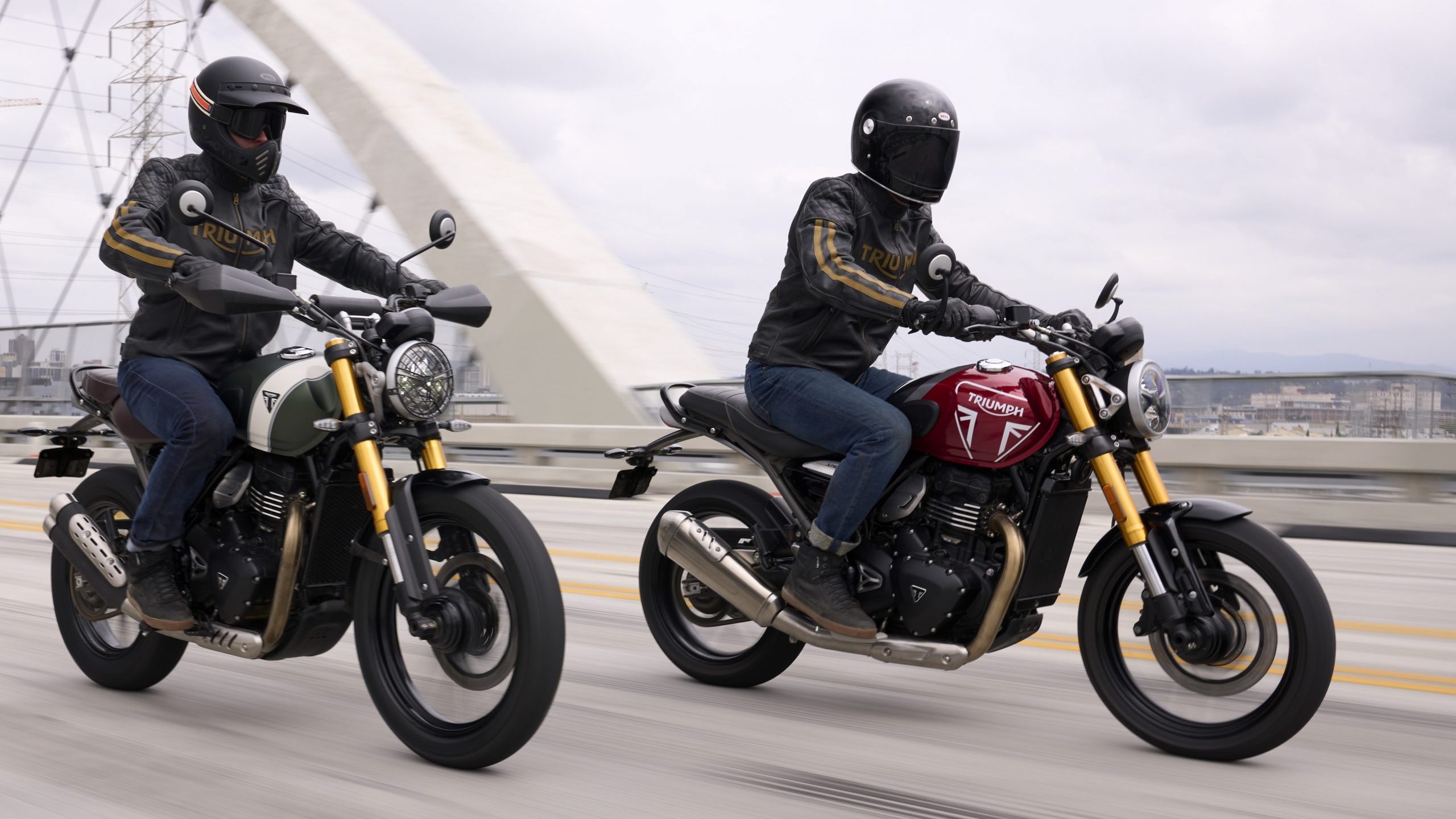
There are a few ways to go about buying a motorcycle after you get your endorsement. Some folks buy their dream motorcycles right away, some buy new, and some buy used.
A lesson I was taught by my riding instructors is that you probably shouldn’t buy that dream Suzuki Hayabusa or that heavy Indian right when you’re fresh out of the class. I get it, you might not be salivating over the bikes on deck for today, but as a new rider, you are likely to make a mistake and either drop your bike or have a (hopefully minor) crash. There’s a neither will happen – I didn’t drop a bike for the first time until six years into riding – but do you really want to chance breaking your dream bike?

This is also why you want to be careful in buying a new bike for your first bike. If you do choose to buy new, ask yourself if you’ll be okay with it possibly getting scratched and dented. Also, be sure to look up the prices for common parts like levers, shifters, pegs, fairings, mirrors, turn signals, or other parts that are likely to be damaged in a drop. Then there are other factors to consider when buying new, like a plummeting resale value.
This is why I love the idea of a used motorcycle for a first bike. You can buy a used machine for dirt cheap, use it long enough to hone your skills, and then usually sell it for pretty close to what you paid for it. You can always buy your dream bike later! That’s what I did.
This time, I challenged myself to find newer used motorcycles that are great for beginners, bikes that have technologies like fuel injection or maybe even ABS.
2019 Honda Rebel 500 – Around $4,000
One of the best beginner bikes of the modern day is the Honda Rebel. Buying a Rebel gives you an easy entry into the cruiser riding style. These bikes are known for their reliability and forgiving dynamics. Newer Rebels like this one benefit from modern technology, including anti-lock brakes and fuel injection, too. The smallest of the modern Rebels are the 300 and the 500. These machines aren’t going to impress your Harley friends, but it’s great to learn on if cruisers sound like the path that you want to take.
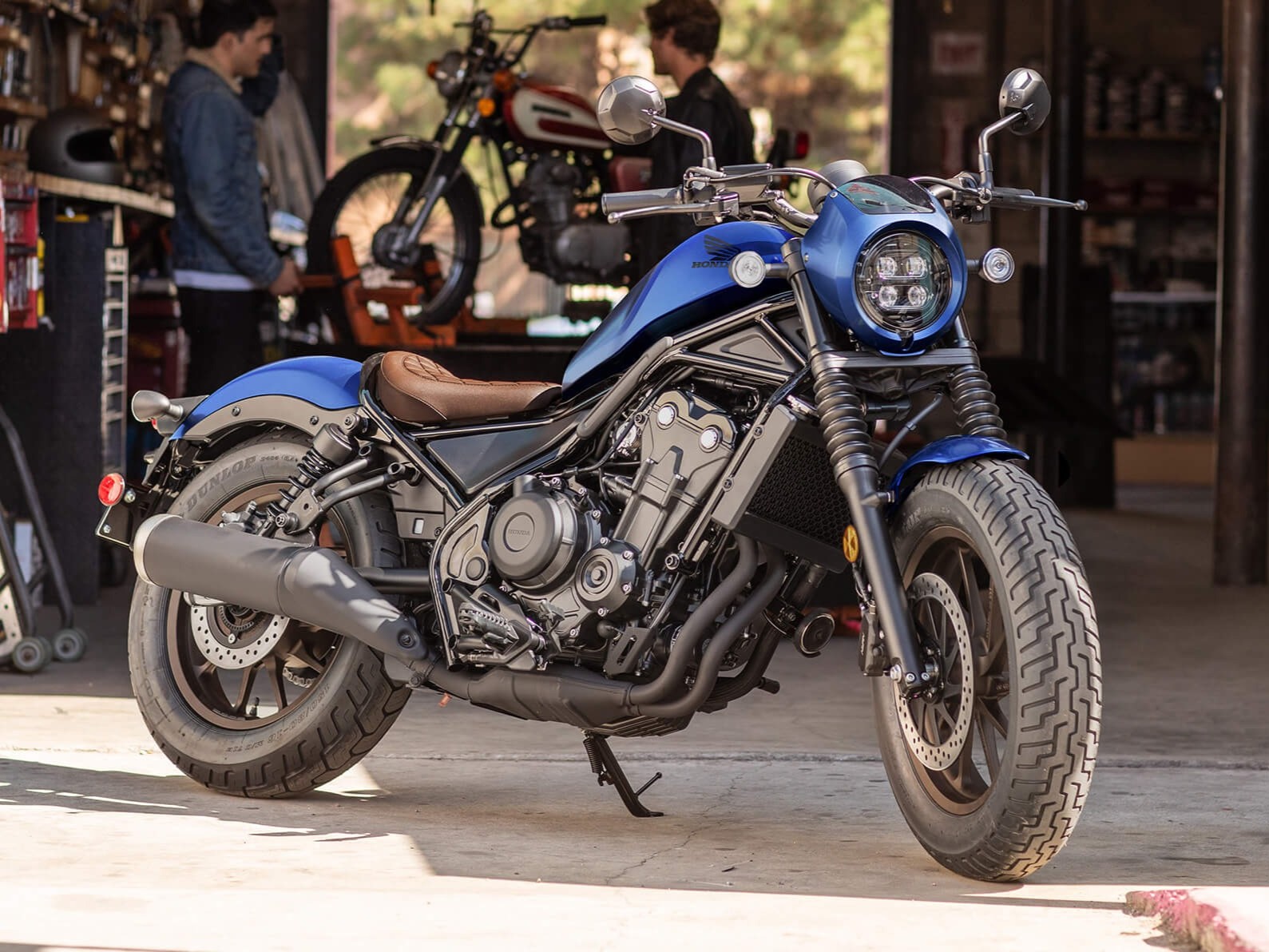
Honda is pretty upfront about the Rebel’s positioning as your first bike, saying that when the line launched in the 1980s, it was supposed to make cruisers accessible for everyone. The original Rebel was also a member of Honda’s ‘Spirit of the Phoenix’ project of the 1970s, which embraced American custom bike culture.
The Rebel 300 is powered by a 286cc liquid-cooled fuel-injected single, good for 27 HP and 17.6 lb-ft of torque. This engine is capable of getting the 370-pound Rebel 300 ABS to 60 mph in about 8 seconds, and the bike races on to a top speed of about 88 mph on a good day without a headwind. This is very slow by motorcycle standards, but also very safe for a newbie! The 408.1-pound Rebel 500 steps things up to a 471cc parallel-twin good for 45.6 HP, 60 mph acceleration in about six seconds, and a top speed of around 110 mph.
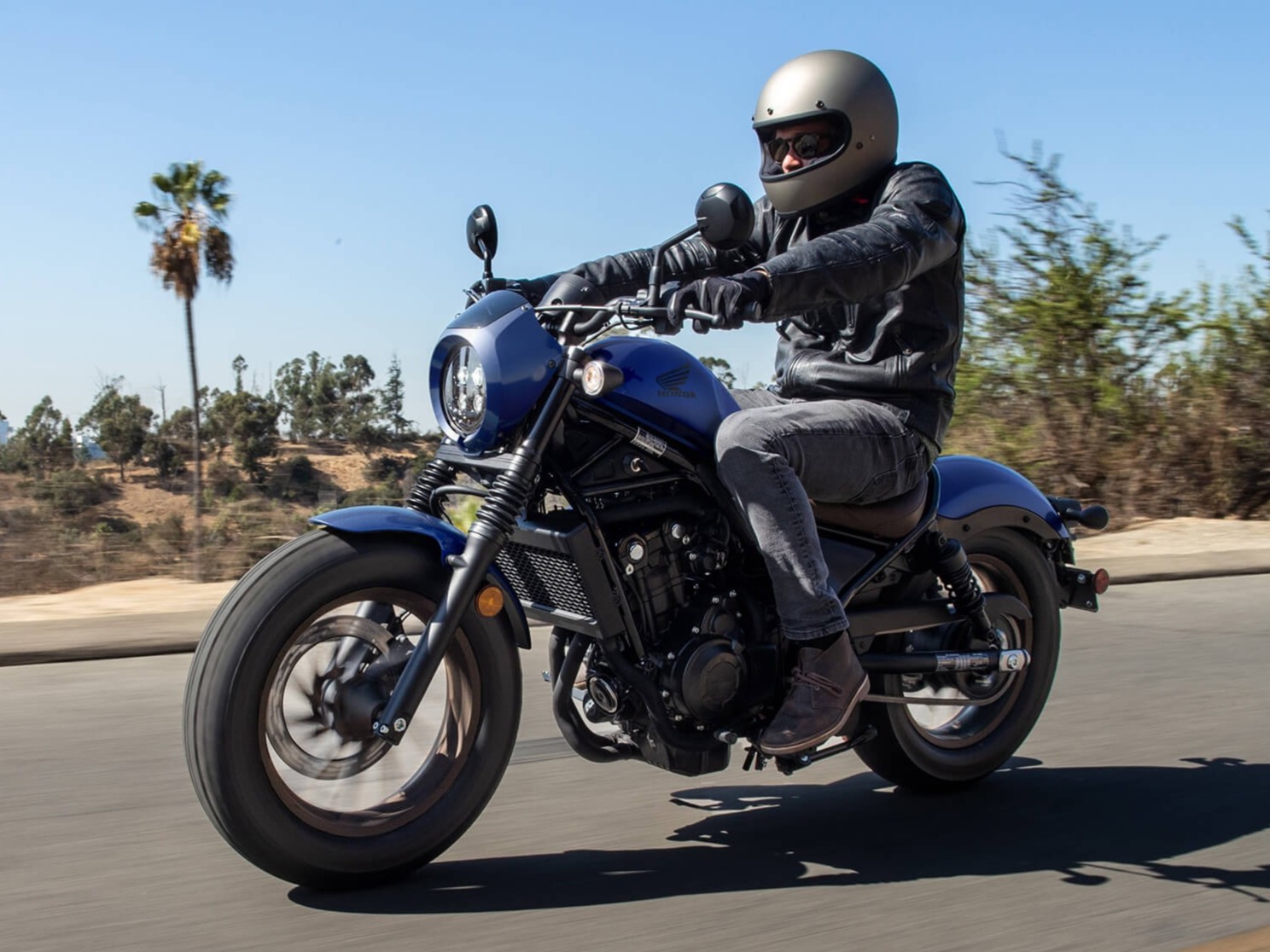
Plusses with both versions include minimal bodywork, a good record for reliability, and a low seat height of just 27.2 inches. You should be able to find a Rebel 500 with a few thousand miles on the odometer for around $4,000, maybe even less if the owner dropped it at some point. A Rebel 300 gets even cheaper at around $3,000 under similar conditions. Of course, prices in your market may vary.
Riders seem to suggest the 500 as a great first bike as it offers just enough performance to keep things exciting after you get some experience, but the 300 is an option if you’re on a tight budget. If you’re on a super tight budget, the old-school carbureted CMX250C Rebel is also an option. You can get one of those for around $1,500 or less if you dig deep enough, and these are even more beginner-friendly with only 18.5 HP on tap and a top speed that’s closer to 75 mph.
If you get a bike that’s very slow, you may end up growing out of it quickly. I had a Rebel 250 that I owned for only a month because my skill had already surpassed the limits of the Rebel 250. So keep that in mind. With that said, the little 250 remains popular among beginners on a tight budget. It’s also popular among urban riders who may never see more than 70 mph, anyway.
2015 Yamaha YZF-R3 – Around $3,500
Alright, so maybe the whole cruiser thing seems so foreign to you, and you’d rather be leaned over and looking like you’re going 100 mph even when you’re stuck in traffic. Hey, I get it! As luck would have it, Japanese brands have perfected the beginner sportbike. These motorcycles are low on weight and power, but big on fun, which is a perfect concoction for beginners.

Honestly, throw a dart at a wall of Japanese motorcycle brands, and no matter which one the dart lands on, you’re probably going to get something good. This time, I’m going to highlight the beloved Yamaha R3. As Yamaha says, the R3 takes a lot of the technology of the firm’s iconic R-Series and trickles it down into a package that every rider can enjoy every day, regardless of skill level.
The R3 was introduced in 2015, and brought along a 321cc 40 HP liquid-cooled twin and a six-speed transmission for the ride. This bike weighs 368 pounds wet, has an accessible 30.7-inch seat height, and has a top speed exceeding 110 mph depending on the rider. R3s can hit 60 mph in under 5.5 seconds stock.

In other words, this is a bike with a tiny, low-power engine, but it has plenty of grunt for beginner fun. But it’s also light enough to toss around. Trust me, if you’re fresh out of training, this machine will feel like strapping yourself to a Saturn V rocket.
Now, there is a risk in getting a sportbike for a first bike, and it’s that these machines are covered in fairings that don’t take too kindly to falling onto the ground. Personally, I recommend getting one that’s been dropped already. Not only will these cost less, but you won’t care too much if you follow the lead of the previous owner and end up dropping it, too.
You should be able to find an early R3 for around $3,500 or so, depending on your local market. If that’s too rich for your blood, go older, and you can get a cheaper bike. For example, the Kawasaki Ninja 250R is a classic beginner sportbike that still goes plenty fast for a beginner and is great to learn on, but costs around $1,500 for a decent example. One that’s been beaten up might be had for under $1,000!
Yamaha TW200 From Any Year – Around $3,500
Yamaha gets two nods in this one because not only does the firm build a great beginner sportbike, but it also builds what some riders feel is pretty much the definitive simple farm and trail bike, the TW200. Many riders don’t really care about hunching over on a sportbike or prowling the streets on a cruiser, but they do want to get far off the beaten path. The TW200 is not just an excellent start for off-roading, but many experienced riders own these things for their simplicity, reliability, and capability.
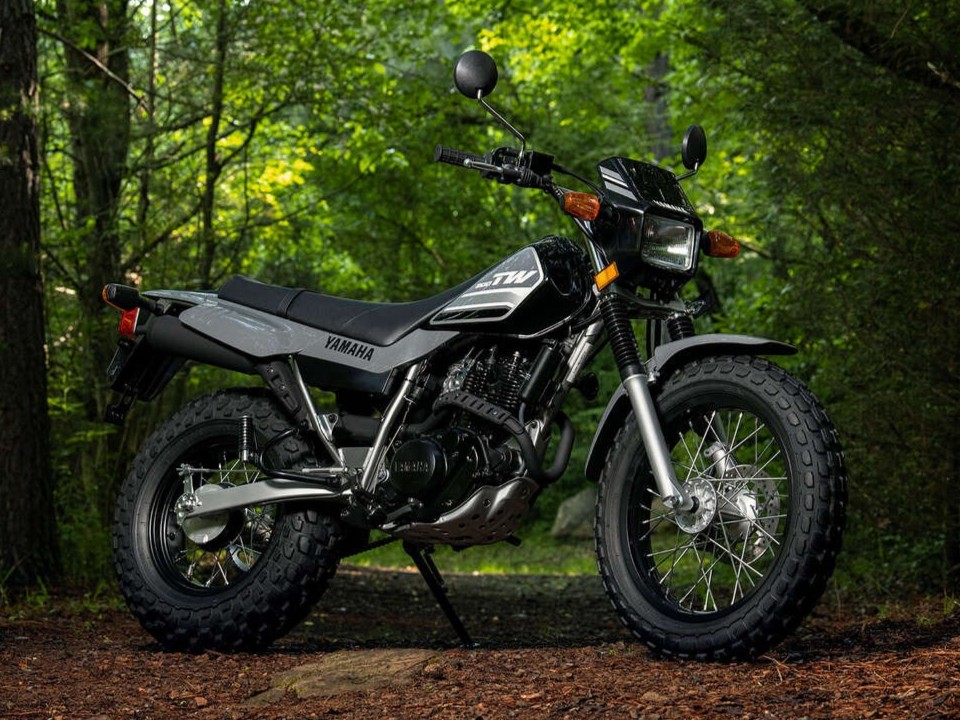
The Yamaha TW200 launched in Japan in 1987, and it’s famous for having a design that has largely been unchanged through nearly four decades of production. Seriously, this is a bike that you can buy new with a rear drum brake, a carburetor, a five-speed transmission, and a wee 196cc air-cooled single cylinder engine. The biggest advancement to ever come to the TW200 was the addition of a disc brake in 2001.
The TW200 is neither fast nor powerful. The engine makes all of 16 vintage horses, and on a really good day, your top speed is 70 mph. You will eventually hit 60 mph, and even the guy on the Rebel 250 will outrun you. However, what the TW200 lacks in speed, it makes up for in incredible versatility. This is a bike that weighs only 278 pounds wet and has a fat 14-inch balloon tire on the rear.
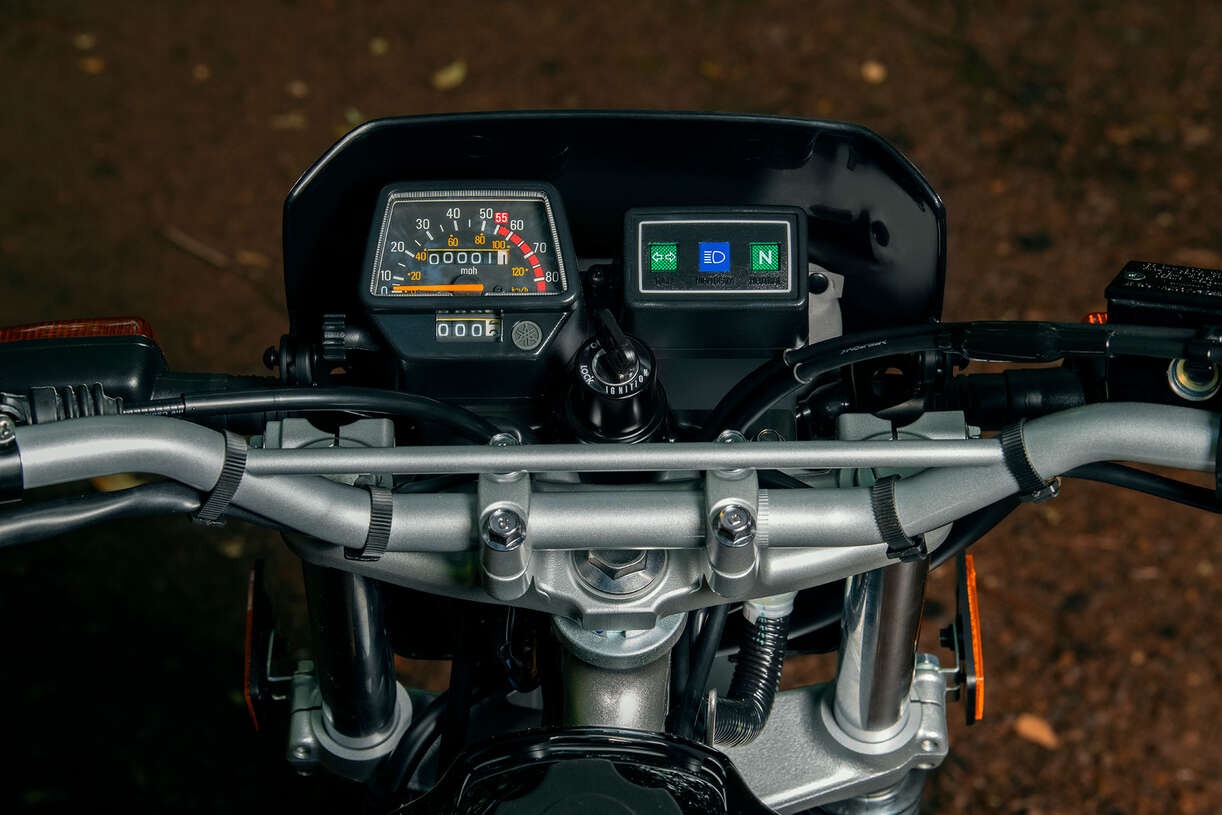
The TW200 is such a good bike for all skill levels that you’ll sometimes find them in rider training classes, and the TW200 still gets nominated as one of the best dual-sports that money can buy.
The TW200 breaks my challenge rule of finding only bikes with EFI, but I think the TW200 is a good exception to the rule. You can repair a TW200 with a wrench and duct tape.
The TW200 holds its value well. Newer ones will cost you over $4,000, while older ones cost below $3,000. Really old ones might cost you under $2,000. A brand-new one costs $4,999, but honestly, don’t bother. As I said earlier, these bikes have been largely unchanged after nearly 40 years of production. Let someone else buy one new and then buy it used later.
2022 Genuine Hooligan 170i – Around $2,600
A lot of riders don’t really care for the whole motorcycle thing and rather enjoy the equally fun thrill ride that is the step-through scooter. That’s perfectly fine! Scooters are a fantastic way to enjoy the two-wheel life. They’re easy to ride, easy to fix, and easy to live with. There are scooters for all kinds of riders, from the under-50cc scooters that may not require a license to the fast maxi-scooters that are capable of exceeding 100 mph.
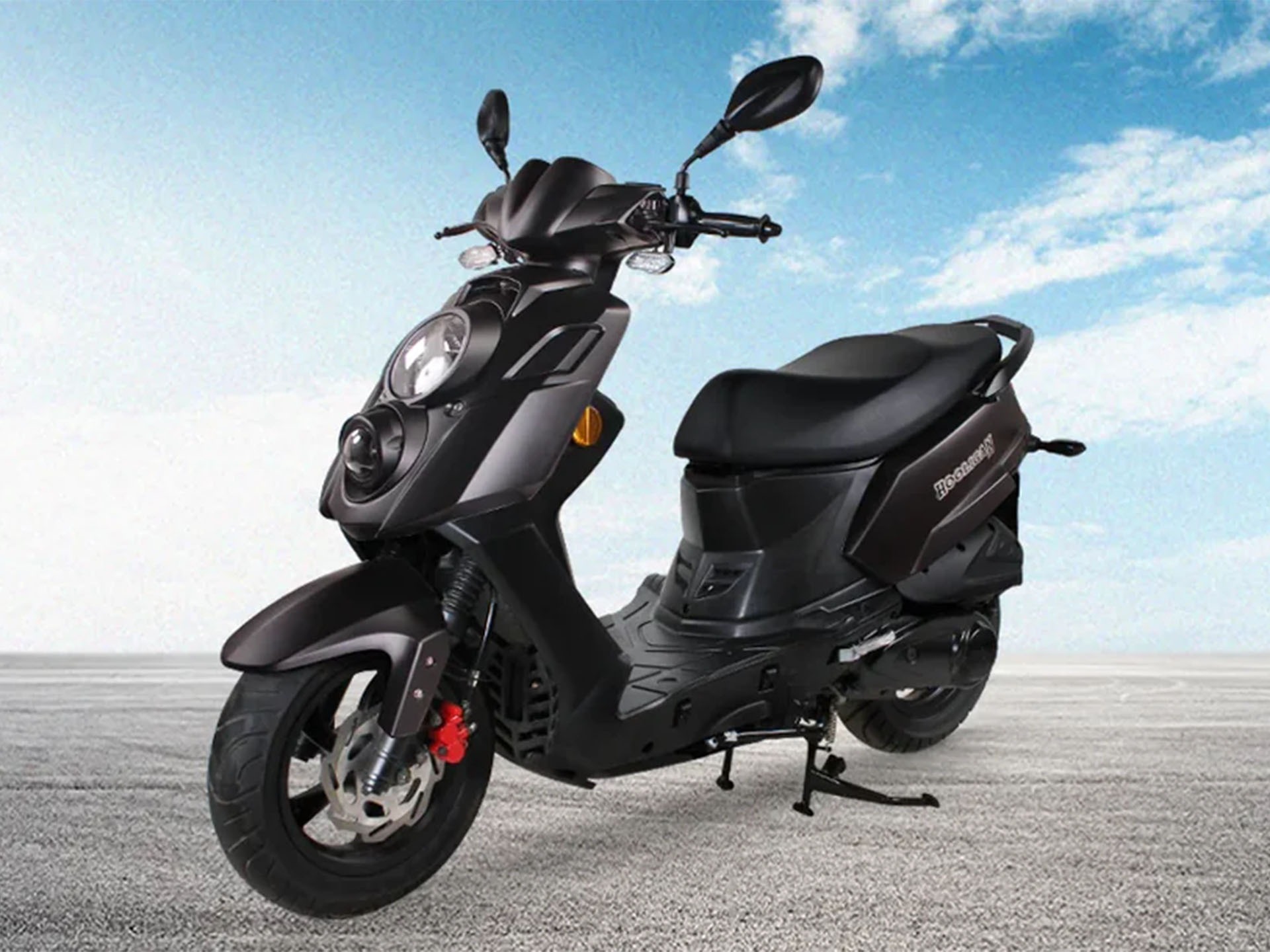
If anything, it might be harder to pick a scooter because the choices are practically limitless. You cannot go wrong with a Honda, and a Vespa is iconic. China also sends over countless cheap scoots that you can ride on the tightest of budgets. For this, I’m choosing a scooter that’s a great all-rounder. The Genuine Hooligan 170i is not so slow that you cannot ride it on real roads, not so fast that it’s going to be a danger to a new rider, doesn’t carry the “Honda tax,” and is made by a known entity.
The Genuine Hooligan is a scooter of the Genuine Scooter Company. You might know this outfit for being the American brand that sold my Genuine Stella when it was new. Genuine outsources the builds of its scooters and that’s not a bad thing. The Hooligan is built by PGO of Taiwan and features a concoction of parts from the PGO X-Hot and the PGO Libra with some special Genuine Scooters flair.
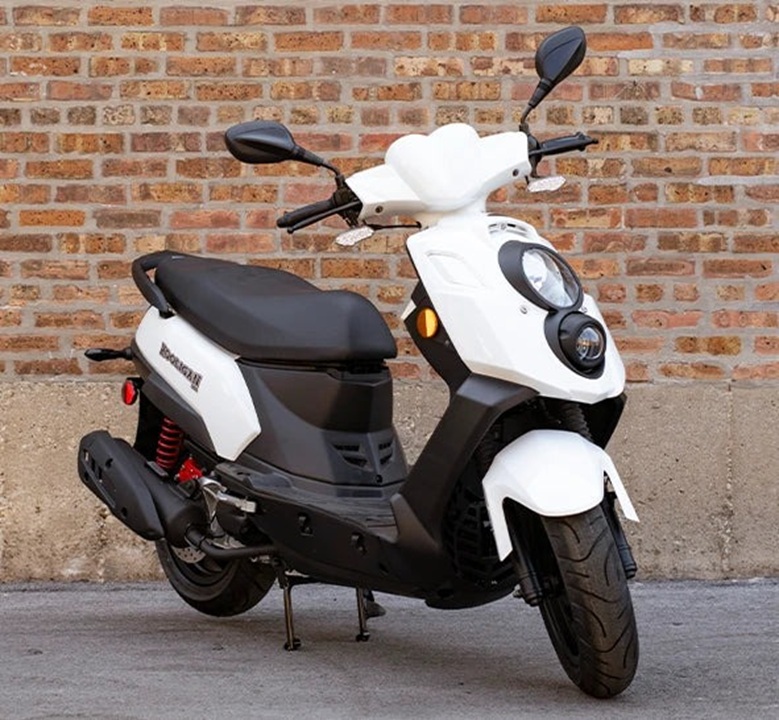
The great thing about the Hooligan is that it offers a ton of bang for its buck. You get fuel injection, pretty decent underseat storage, front and rear disc brakes, and even a USB port to charge your phone. Power comes from a 168.9cc air-cooled single, good for 11.2 HP. Genuine Scooters says that the Hooligan can hit 60 mph, get well over 100 mpg, and has a low weight of just 278 pounds. Even the seat height is an accessible 30.75 inches.
Sure, the Hooligan doesn’t have the name recognition of Honda or the flair of a Vespa, but these appear to be pretty reliable steeds for all kinds of riders. Reader Shop-Teacher has owned more than one Hooligan over the years, and he swears by the little cutie.
It shouldn’t be too hard to score a used Hooligan for under $3,000, or even under $2,000 if you don’t mind some miles and maybe a scratch or a few. New, these scoots cost only $3,699.
2022 Royal Enfield Classic 350 – $3,500
Alright, so you love a motorcycle with classic looks, but you don’t want to deal with a 40-year-old bike’s carbs or electrical system. I get that!
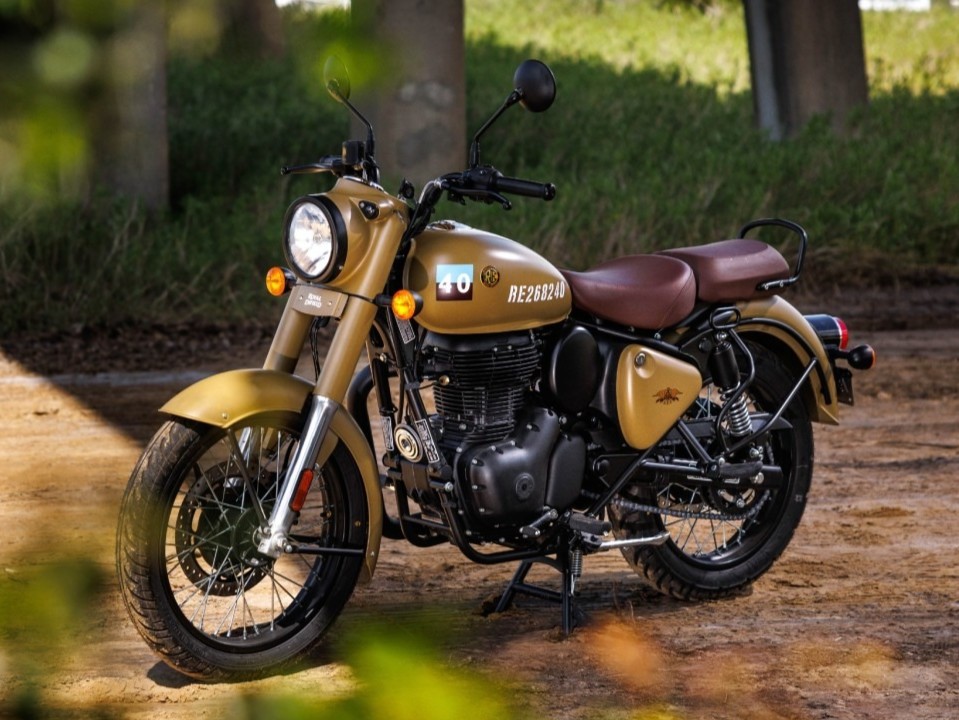
Last year, I recommended a 1978 BMW R 80/7 as a great beginner-friendly vintage bike. If you won’t mind spinning a wrench, I still recommend vintage bikes. They’re often cheap to buy, great to teach yourself how to wrench, not very fast, and are often already imperfect with the bumps, scrapes, and dents of several decades on this planet. Most of my earliest bikes were Japanese machines from the 1980s because these bikes were built so well that they were still reliable decades later.
However, vintage bikes do have their quirks. My old 1982 Suzuki GS850 was ridiculously top-heavy, and it would have sucked to lift if I ever dropped it. I also had silly failures. One time, my clutch cable snapped, forcing me to nurse the bike home using rev-matching and the starter motor. My time with that bike ended when the gas tank’s protective coating started breaking off and clogging the rack of four carbs.
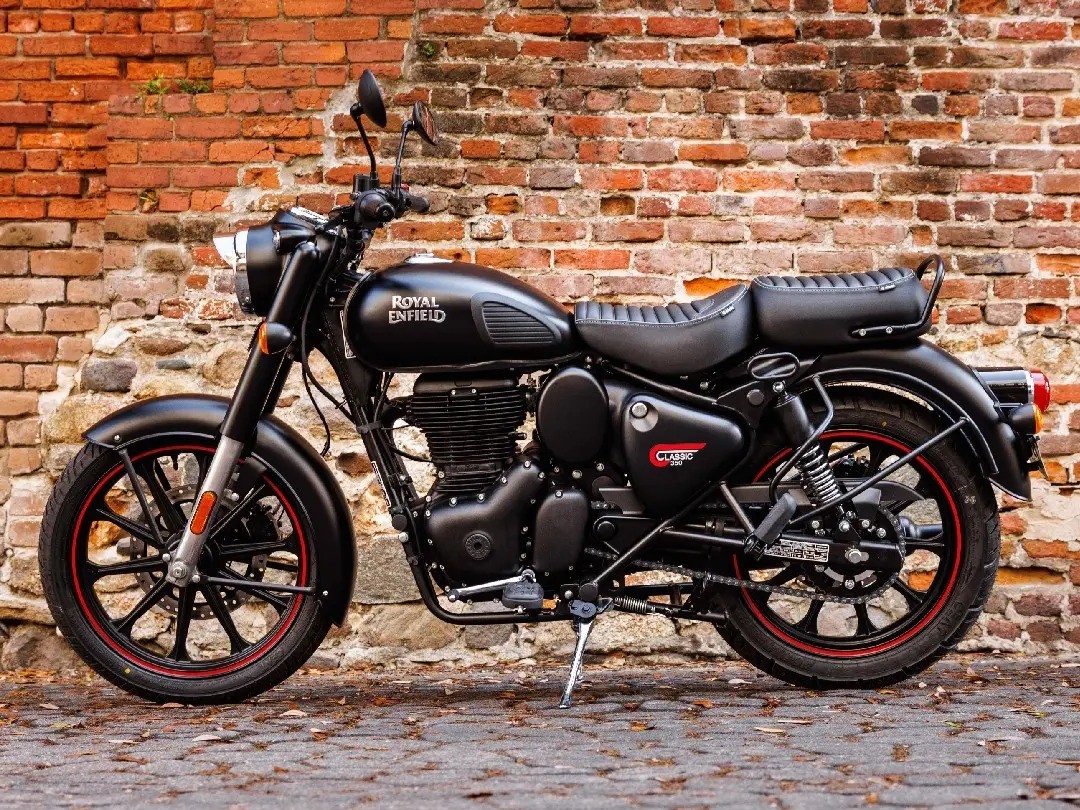
Understandably, you, as a beginner, might not want to deal with all of that. Thankfully, you can buy modern motorcycles that look vintage, and Royal Enfield has been the beginner favorite for years. Royal Enfield’s motorcycles aren’t just cheap to buy, but they are cheap to repair when a beginner drops their bike. Sure, these bikes are going to be very slow and have more frequent service intervals than the competition, but they are easy on beginners. The folks of RevZilla found out that Royal Enfields are light to pick up when dropped, too!
Honestly, Royal Enfield’s lineup is full of rockstars right now, and you should have a ton of fun no matter which bike you pick. I’m a huge fan of the Classic 350, which is a standard motorcycle that’s styled like a classic, but features modern bits of kit like fuel injection, a USB port, and dual-channel ABS. You can even fit a neat turn-by-turn navigation device onto the Classic 350 and still maintain the bike’s excellent visuals. I put my money where my mouth is and bought one for myself, and I’m still in love with my purchase.
Power comes from a 349.34cc air and oil-cooled thumper making 20.2 HP and 19.9 lb-ft torque. This is less than the kind of power that 250s made three decades ago. Obviously, speed is not really in the wheelhouse of the Classic 350, but mine will hit 75 mph given no wind and a very long enough stretch of road to slowly watch the speedometer needle rise. Cruising speed is really closer to 60 mph, so the Classic 350 is a better fit for country roads rather than the highway.
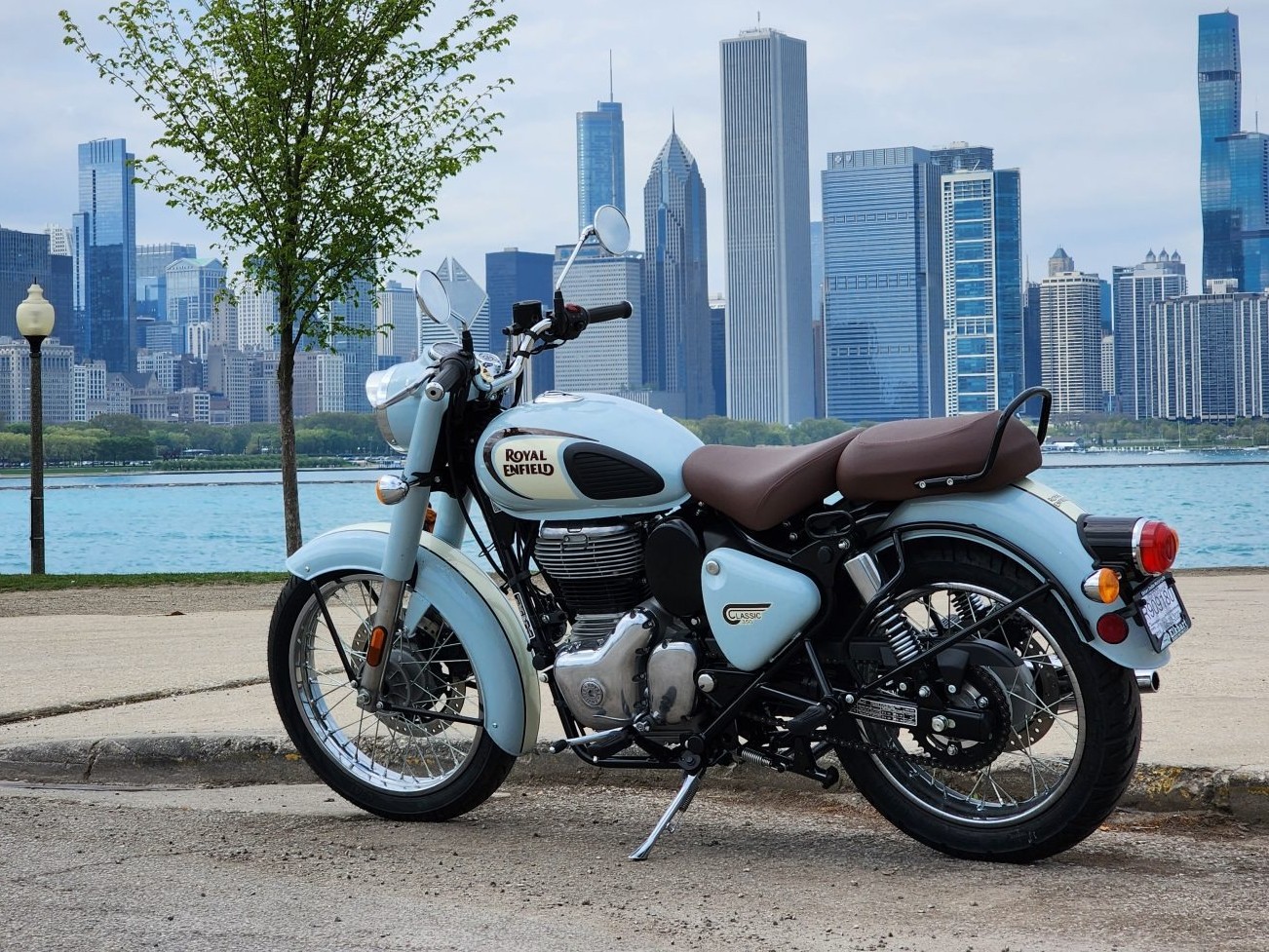
One of the quirks with the Classic 350 is that it weighs a chunky 430 pounds. This is largely because it features heavy metal in places other manufacturers have long replaced with plastic or other lighter materials. That fender? It’s metal, baby!
These bikes hold their value relatively well, and you can usually find them for under $4,000. Some sellers who are desperate to get rid of theirs might let them go for $3,000 or maybe less. New, a Classic 350 runs $4,999, but you’ll be paying closer to $6,000 after fees.
If the 350 is too slow, you can get more than double the power out of Royal Enfield’s 650 platform, which consists of parallel twins that make 47 HP. These should be easy to find under $5,000, and sometimes you will find them for under $4,000.
Gear Up And Have Fun
One motorcycle that I have not included on this list is the Suzuki SV650. This motorcycle is often suggested for beginners, especially those who might want to try out track riding someday. However, I’ve also often seen people recommend against the SV650, which makes over 70 HP, because it’s a lot of motorcycle for someone who might have ridden a slow sub-10 HP 125cc motorcycle in their training class. But it is an option if you think you’re at a skill level where you can handle the power.
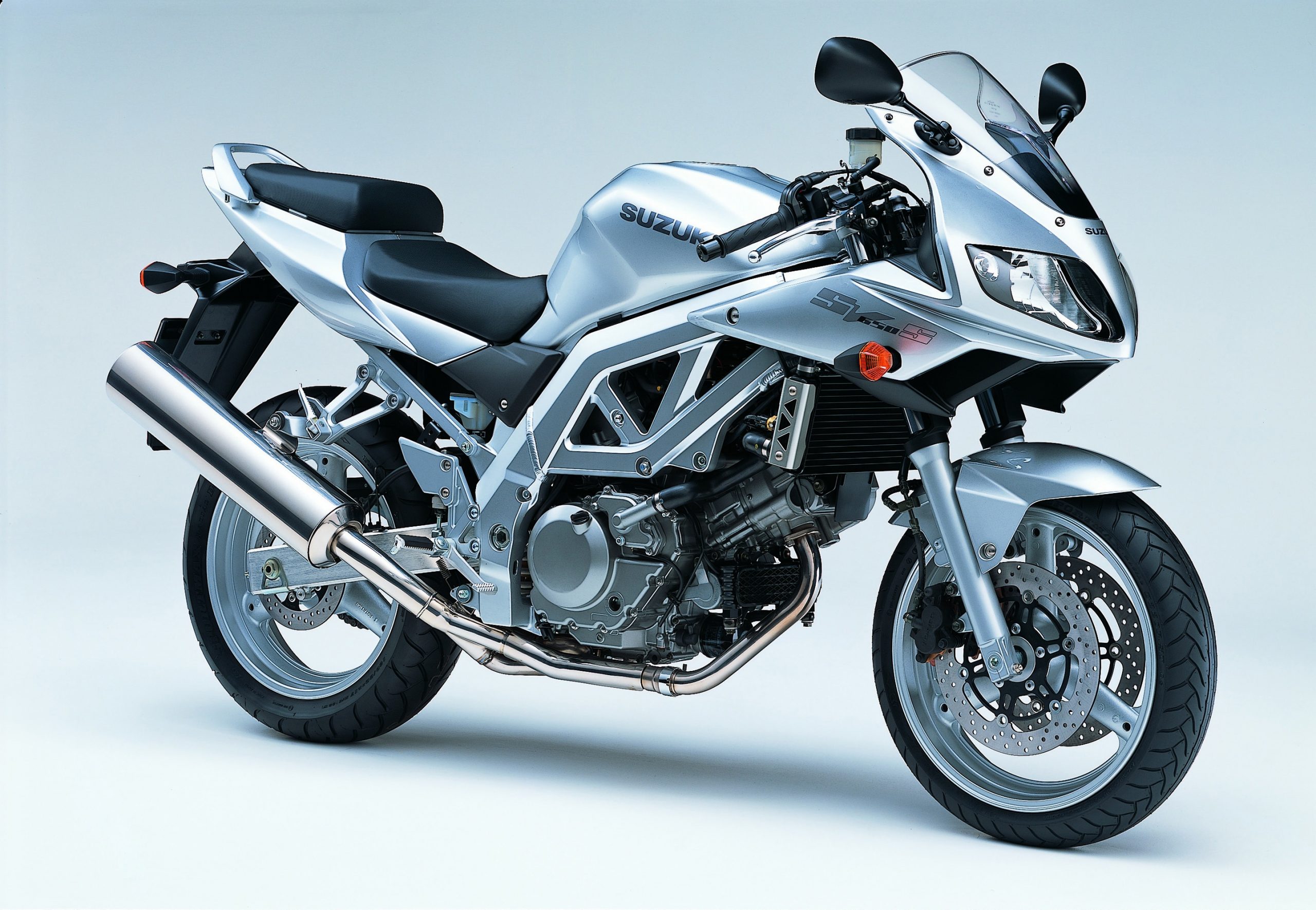
Other honorable mentions that I’ve included in pictures are the KTM 390 Duke, the BMW G 310 R, and the new Triumph 400s. Lots of novice riders are on these bikes and are having a ton of fun.
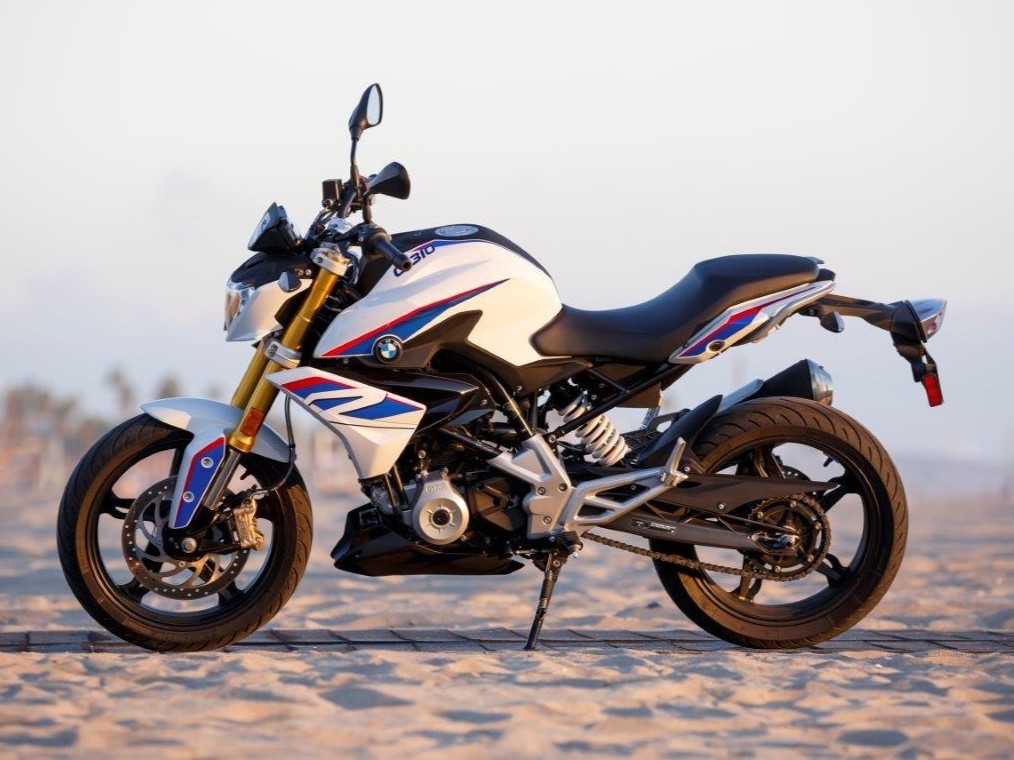
If you’re not already a motorcyclist and are interested in becoming one, I highly recommend taking a motorcycle safety class. There are motorcycle safety schools all over the country, from various sources, from local organizations to companies like Harley-Davidson. I recommend paying a visit to the Motorcycle Safety Foundation and finding a class near you. These classes will teach you the basics of riding a motorcycle as well as life-saving skills that can even help you behind the wheel of a car or at the controls of an aircraft. Depending on where you live, motorcycle training may be free! These classes tend to be full at the beginning of the season, but you may have luck now as the traditional riding season nears its end.
Either way, before you head out onto the road, be sure to dress for the slide, not the ride. Buy the best gear that your money can afford. Even cheap gear is better than no gear at all. I may look like a goofy Power Ranger when I ride, but it has meant that I have survived two motorcycle crashes with little more than a shaken emotional state and a cool story to tell. Riding a motorcycle is fun, but coming home to your family is even better. Be safe out there!
This list is not an exhaustive one. There are lots of other great beginner motorcycles out there. I didn’t even touch KTM, BMW, Triumph, or what other brands are doing with beginner-friendly bikes. If I did, I would be at this all day. At the very least, if you’re looking to dip your toes into two wheels, at least this should give you a good idea.
(Correction: The TW200 got a new brake and a removed kick start in 2001, not the addition of electric start. We corrected the issue and regret the error.)

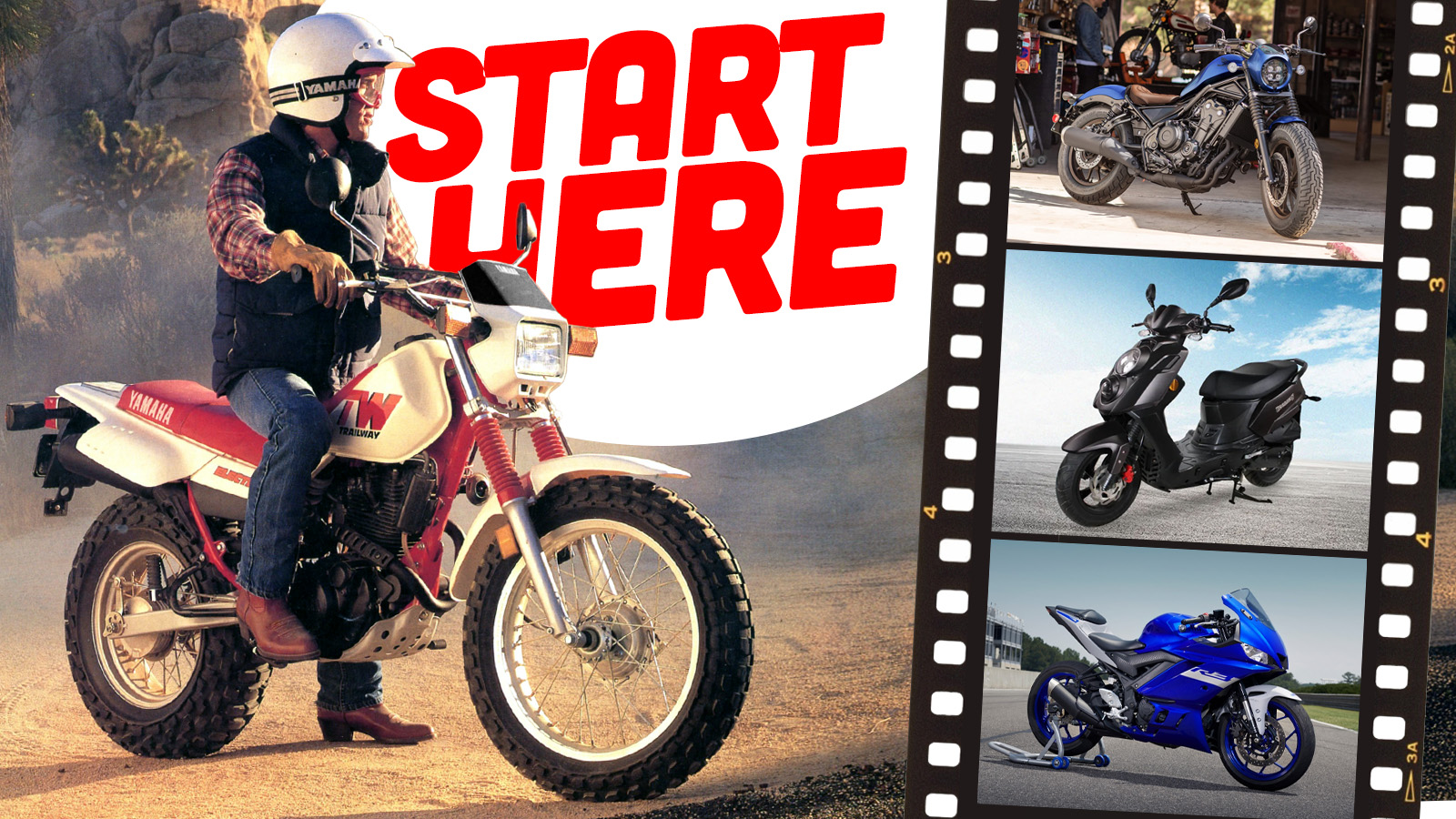



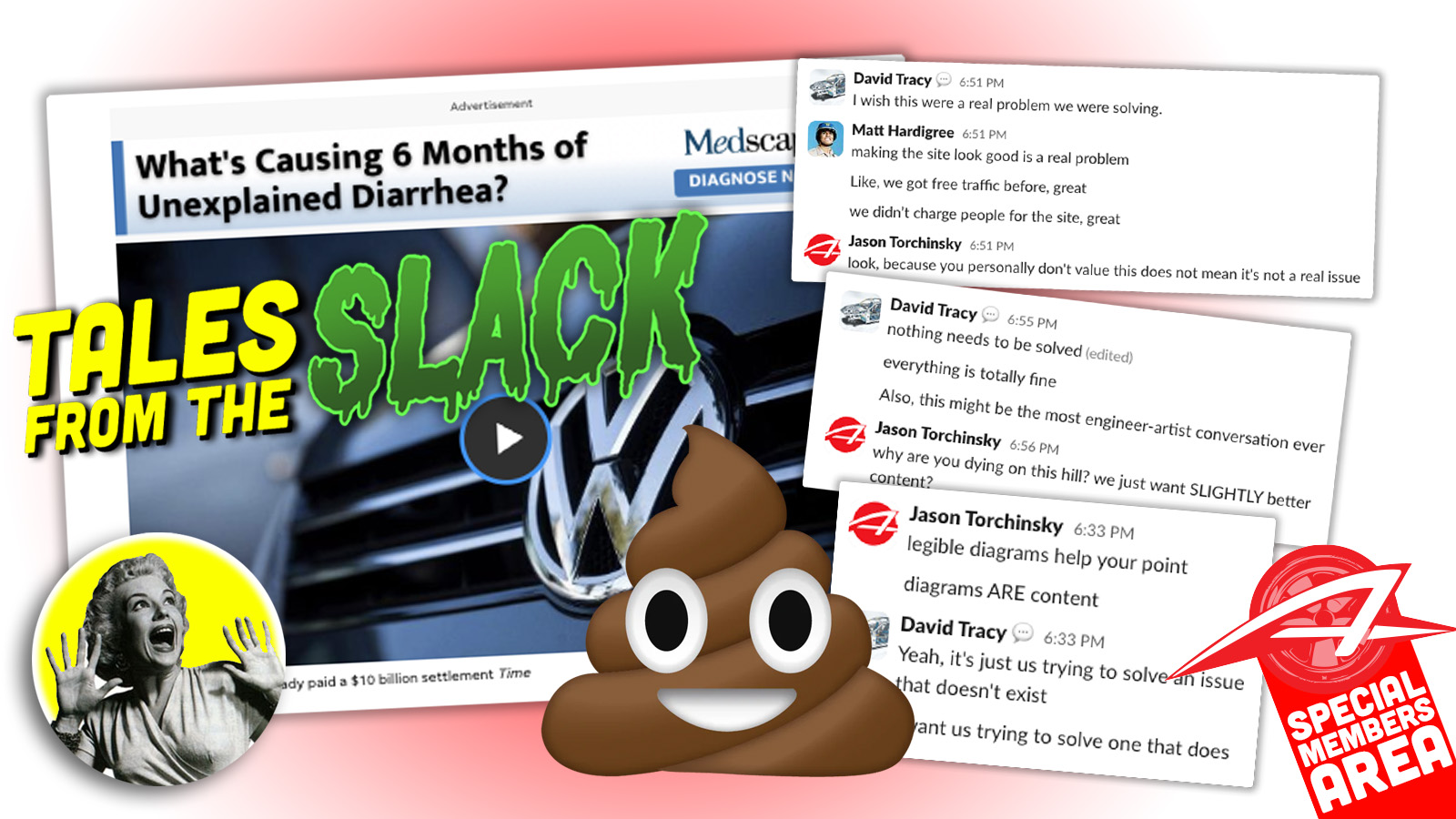
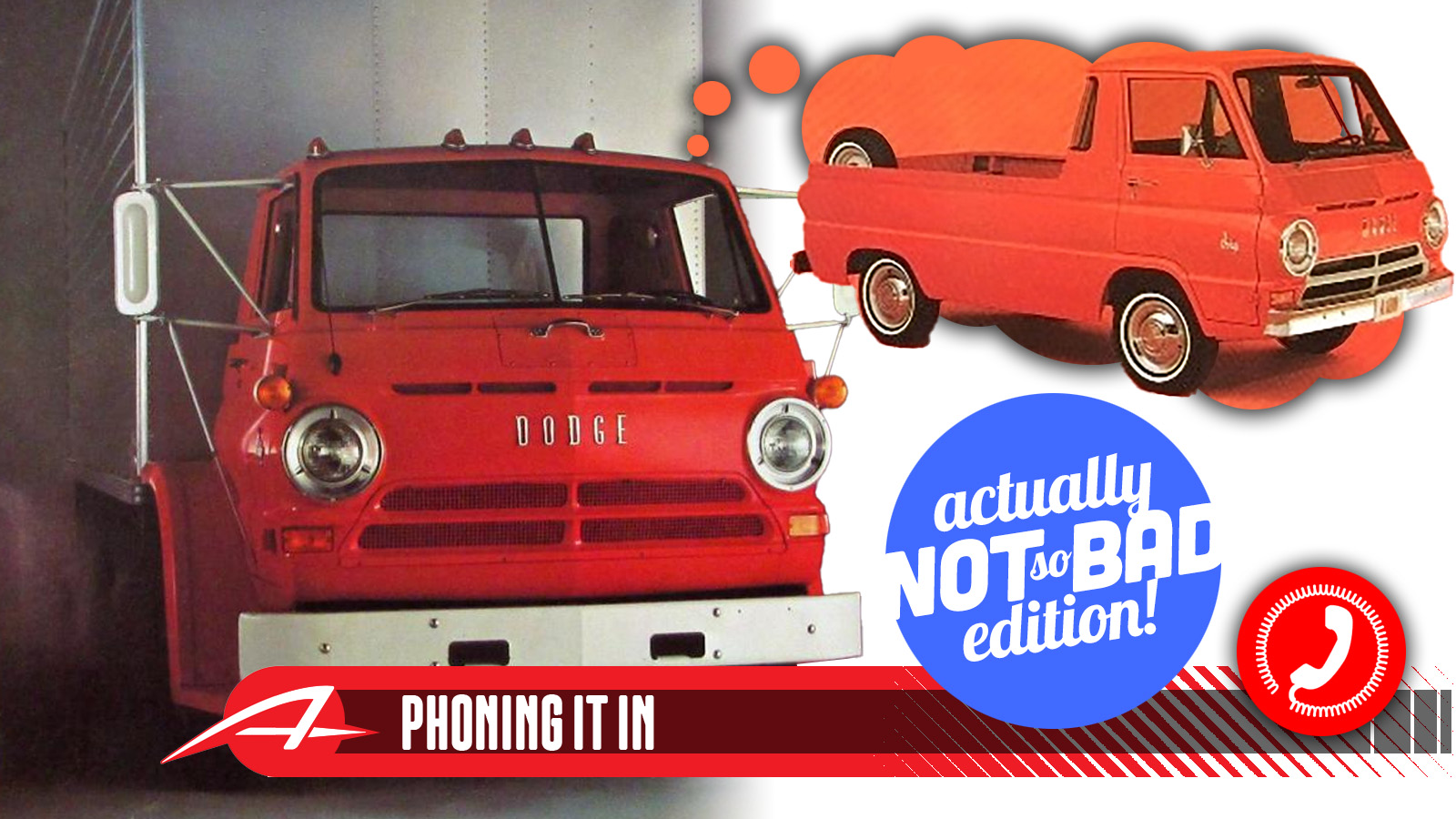
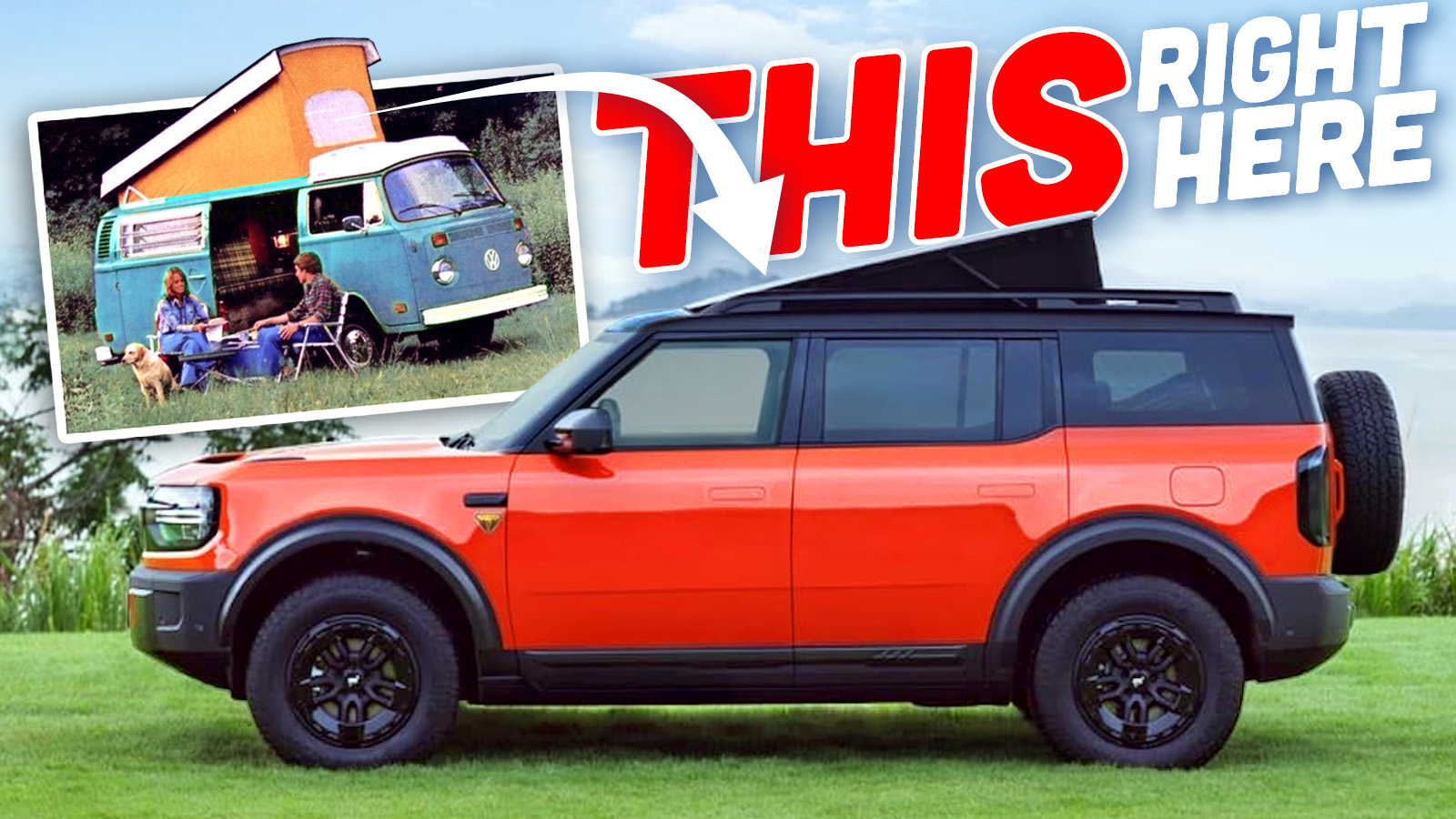
The right time to buy that motorcycle, is after the first rain or snow of the season. Prices tumble fast.
Two I’d recommend, a Suzuki DRZ 400SM or a Yamaha WR250X (both supermotos) with the edge going to the WR for being EFI and happier cruising north of 70mph (due to a 6-speed and gearing).
Both offer a more upright and beginner-friendly riding position, both are fairly light handling, and both (being dirt bikes at heart) will be able to withstand being dropped with almost no damage cosmetic or otherwise. If you happen to live in an area with plenty of twisty back roads, both have more than enough handling capability to give you plenty of “room to grow” without having overwhelming power. Also if you are blessed to live somewhere with lane splitting, both have higher bars that will clear a lot of mirrors.
These are user friendly no doubt, but they are somewhat tall though.
I will admit you’re correct… I think the DRZ is the taller of the two by about 1/2 an inch.
My WR felt “short” to me because I could comfortably sit with the balls of my feet on the ground where on my true MX bike I was more on my toes.
Slightly-warmer-than-room-temperature take: you should intend to outgrow your first bike, and you should wring every last drop of experience out of it before you move on.
It’s why I find it hard to agree with the “get something you’ll grow into” philosophy – a first bike is by default beyond your riding skills; that’s why it’s a first bike. Why widen that disparity by going for a dream bike first?
I took a class a couple of years ago for my motorcycle endorsement (one of my 50 things in my 50th year). We trained on Yamaha MT-03s and KTM Dukes. Neither “fit” me well. I always liked the Honda CBs, I went out and bought a 90s vintage Nighthawk 750. So far, so good!
I think taking these classes is the best idea. When I took the class z dozen(?) years ago, I actually got to try out a few different bikes. They had a Rebel 250 and a TW200, and some other bikes that I can’t remember now. It was fun. It’s also good for an absolutely beginner to see if this is something he or she wants to continue pursuing.
KLR 650. You will grow into it in a few months. Explore, don’t just ride.
I would not recommend any of these as starter or completely beginner bikes.
Most on the list are intermediate, except the scooter and maybe the TW200 is slow enough.
But scooters aren’t good to learn as they’re automatic, and the TW rides a bit unusual with that tractor rear tire.
Since 50cc manual bikes and 125cc commuters are so rare in the US, start on something like an XR150L, that’d be the closest thing to a true beginner bike.
Or even better, start with a 100-150cc 4-stroke trail bike, off-road.
Off-road skills give a lot more slow-speed and tight maneuvering confidence that’ll be very useful on the pavement too.
The Rebel was the first thing I thought of when I saw the headline.
I acquired a 2017 Rebel 500 when some money that was owed to me wasn’t going to be forthcoming. Between the loan and cash I handed over I was in it for $2400 in 2024 with 750 miles on the clock. The previous owner had been doing some chopping on it before I got it, so I had to fabricate a rear fender and muffler, and rework all the lighting. I added forward controls for comfort since my old dad bod hips didn’t like the mids.
I definitely think the <500 Rebel is too small and most people will outgrow it quickly. With the 500 I sometimes long for more, but it’s just enough bike to scratch the itch and not enough to let me get in any serious trouble. Occasionally I’ll push it too far and it will remind me, in a startling but non-injurious way, that I’m not that guy and it’s not that bike, so I need to calm down. Which is fair.
I see your argument against the SV650, but I would counter with a few points:
The SV650 is a full-sized bike. For someone who’s taller: this is really really important. It allows you to comfortably sit on the bike without feeling stretched and/or bent in awkward directions. The comfort factor, alone, contributes to the ability to better control the motorcycle. It’s not so large that it’s ungainly (e.g. Triumph Rocket3) nor so top-heavy that it’d intimidate more than the bikes you’ve already suggested (in fact, I would argue it’s less top-heavy that some of the options you list). Due to it’s longevity on the market, aftermarket seats with higher/lower seat options are easily found.
Unlike the dirt-bike derived options you gave, the seat is available at a near-normal height for a motorcycle and has a firmer road-going suspension. Dirt bike seats are designed to give you advantages for offroading that aren’t needed on the road. The firmer suspension will give you better confidence in the corners, and at higher speeds (anything more than city-speeds).
The SV650 is also reasonably plentiful in the used market. It’s a bike that’s been around for many many years (I would argue the early ones are the most attractive) so prices for the bike, as well as availability of parts, are all very good.
The hp, arguably, is on the higher-scale of what you’ve suggested is actually very smoothly delivered. I think this is a red herring of a statement to male. Yes, you can get yourself into trouble, but the linearity of power delivery of an SV650 allows you to better control it than, say, a 600-four sportbike.
If your argument is solely around the hp rating of a motorcycle: restrictor devices are readily available for major motorcycles from jurisdictions in the UK/IRE that will bring you down to 35kW (47hp) – a quick look finds these for ~£65.
But the greatest advantage to the SV650 isn’t that you can take it to the track: it’s the massive versatility of the bike. You can use it as a bike to learn due to its good ergonomics, and smooth power delivery – but also, well respected by veteran motorcyclists as an “everyday” motorcycle that you can commute to work, carve a canyon, throw some bags on and tour the country, or, yes, even take to the track.
The only downside, I would have, to the SV650 is that I don’t find the build quality of Suzuki to be anywhere near Honda or Yamaha. And it’s a shame we’ve not had a re-release of the NT650 Honda Hawk, as it would have been a formidable bike to compete against the Suzuki – even if it carried a premium to the pricetag.
Another bike that I didn’t see on your list is the DRZ400. Which would be a bit more useable than the TW200 on the road – especially if you find the -SM version with its street tires.
I learned on my dad’s small fleet which included a Suzuki TS125, a GS250, and a BMW R75-5. The BMW was really too heavy for 16yr old me but they were all great in that they didn’t have a ton of power and were older than I was so they weren’t precious.
My first bike was a RD-350 with a bit of tune which was a ton of fun but I think my ratio of hours riding to hours wrenching was 1:2 which probably made it the safest bike as well – hard to crash in the shop or the driveway! When I bought the RD I test drove a KZ1000 and thankfully realized I was not ready yet for a bike with over 100hp and no nannies.
Now I’m 25 years older with thousands of miles riding but currently without a bike and I am reading this list and if I am being honest with myself these look like more fun than a modern Speed Triple with over 175 hp and correspondingly stupid top speeds.
This list is not bad. Used, standard seating, smaller displacement, light weight. Those are the key criteria for best first bikes. Triumph 400 and Royal Enfield 350 ranges are great first bikes, and are not too pricey new. I’d also recommend the Yamaha XT250 over the TW-200, as it is a more capable commuter and is still useful off-road.
A good list!! May I suggest an alternative to the TW200 that has the same size engine, same fat baloon tires (and can take a 14″ fat boi up front too!), capable of 65-70, and has EFI?
Suzuki VanVan 200, or bangbang 200. Sold from 2017-2019, they go for 3-4k as well but have the benefit of Efi. Theres a smaller aftermarket, but it makes a great learner bike.
A plated dirt bike is the answer full stop. If you can’t be bothered, something light that you are OK dropping. Maneuvering a motorcycle is awkward when you’re new and parking lot maneuvering takes some getting used to. Get something you can drop in the parking lot and then not worry about fixing.
Wear your gear. Ride like you’re invisible and if cars could see you they would actively try to kill you. Head on a swivel.
I get so annoyed at the if not when you go down folks. I’ve been riding on the street now for longer than I haven’t (26 of my 45 years) and outside of the aforementioned parking lot mishap (on wet leaves, no less) I have never haddalayerdown. Outlier? Maybe…but I’ve lived and commuted in Appalachia, Philly, SoCal, the Rockies, and now Appalachia again.
I am just now getting to be a little tired of being so aware and focused when riding. That and gearing up in 90 degree heat have me riding less. But I will always love motorcycles.
I definitely agree with your third paragraph (well, the whole comment, but that’s a big one for me).
You run into people in a lot of hobbies/sports/interests who assume everyone will have mishaps, and one of the worst things they do is conflate avoidable mishaps with unavoidable ones. They’ll have someone believing that riding too fast for conditions/skill (or handling a gun improperly, packing a chute improperly, etc.) is fine because these problems (laying down a bike, negligent discharge, tangled lines) just eventually happen.
There’s something to be said for recognizing that there are some circumstances outside your control (drivers, for example), but that should be with an eye toward preventing issues and mitigating them if they can’t be prevented, and too many people use perceived inevitability to get complacent.
Agree with this entirely – the only times I have ever gone down were off-road doing something dumb – crashing is absolutely not a forgone conclusion.
That said though my first advice for new riders is wear your gear all the time. Sure, you don’t need full leathers and an airbag to head across town to run an errand but helmet, gloves, and real shoes go on for every ride.
Like everyone else has said keep full awareness and assume everyone will do the stupidest possible driving around you but in addition to that plan your route to avoid road conditions, intersections, and areas where you have less control. I am in north Jersey and there are several sections of the Garden State Parkway where I would never consider riding because the general aggressiveness and traffic are not worth the risk for the 10 minutes I might save.
I totally wasn’t counting crashing a dirtbike. I feel like that is part of riding off road.
Yeah crashing is basically a given in off-road riding but I have certainly had dumb decisions make things worse – like getting on a tuned two-stroke I was unfamiliar with, on rocky trails I was unfamiliar with, while trying to keep pace with side-by-sides just after a light rain.
Even then though because my helmet, gloves, and boots are on for every ride, I ended up bruised and with a couple new scars but nothing some advil and time feeling sorry for myself couldn’t fix.
What about something like a Ryvid Anthem? Does anybody have any beginner experience with those?
I have a no-highway commute to work and something like this really tempts me. The streets are too busy to ride an ebike during rush hour so i want something that can actually keep up with traffic flow.
It’s double the price of anything on this list, but a) it looks really cool and b) is electric and c) seems to be in the power range of a lot of things on this list.
The price means it really doesn’t work as a starter bike. You can get similarly capable new bikes for less than half the price, and really good used ones for 80% less. No reason to spend that much money before you know what you are doing and what you really need. BEV motorcycles carry an immense premium for what they are.
I mean, price is A factor in choosing a bike, not THE factor. There arent many of these bikes in the wild at all, but eventually there will be a few used ones too.
Just because it is eyewateringly expensive compared to similarly performing bikes, doesnt mean it doesnt work as a starter if the person is willing to pay the premium to be zero emission.
I would be surprised if the Ryvid Anthem ends up being a net benefit on emissions. BEVs have a higher initial environmental impact and take meaningful miles to break even. BEV motorcycles make putting on miles very tough. Plus, that $4-6k premium would likely be better spent upgrading to a PHEV, adding insulation and/or solar to your house, or just buying offsets from a reputable source. Maybe if you can get a used one for 50-75% less, after it has gone off the BEV depreciation cliff, it could be worth it. Generally, motorcycles and HD pickups are the worst use cases for BEVs.
I feel that, but i feel like you are really discounting this part: they look really cool. The synergy between looking cool and being BEV is what tempts me in a way that other legitimately cool looking bikes like the Enfields dont as much.
It’s not a purely rational thing. It’s a coolness thing. They appeal to me as being cool.
Wildly subjective take. To me it looks like an e-bike that someone glued a honda generator in the spot engine would be on an ICE motorcycle.
Well yeah! Cool is always subjective.
Well, wanting something just “because” can’t be argued against. That’s for sure.
I’ve owned over a dozen motorcycles over the years and always found prepackaged “cool” factor to be the worst part of riding. The people I rode with were incredibly inclusive of new riders and owned everything from new exotic Italian race bikes to cross-country prepped KLRs to clapped-out old 2-strokes. The only riders that caused us pause were the new riders who bought an expensive new bike to be cool. Typically, middle-aged guys on Harleys or big BMW GSs or young guys on liter sports bikes. They typically were more interested in posing than being a part of the community, and caused issues. The difference between people who are enthusiastic about the act of riding a bike and those who want a fashion accessory.
A cheap first bike lets you figure out whether you actually like riding.
And so much of what looks cool to someone without a knowledge base does not help function (or, worse, actually makes things harder to use).
For sure. Which then means they look the opposite of cool to the community they are joining. It is like the new skiers who buy top-of-the-line equipment and the most expensive gear and then snowplow down the slopes.
All that tho is the entire essence of me asking the initial question.
“Hey, this bike i think is cool and seems to be similar in many ways other than price to the bikes on this list. Does anyone have experience with it?”
Nobody has answered the question, the bike has just been generally crapped on, which is the opposite of being incredibly inclusive of new riders even though in everything but price, the bike appears to be (from an inexperienced perspective) a good beginner bike.
It’s not trying to be a full liter sport bike. It’s trying to be an urban commuter… That i think looks cool.
It is unconscionable to me that you are presenting people who want to enjoy “the act of riding a bike” as being mutually exclusive to people who want to… like the way the bike looks?
As the Old El Paso girl says: porque no los dos?
I am in no way implying that people who like to ride can’t like bikes because of how they look. It is a huge part of what people like about motorcycles. But the big issue in any subculture, such as motorcycles, guitar playing, or skiing, is that there is a natural wariness when people look like they are attempting to buy their way in simply to leverage the cache of that subculture without having added anything to it. So, the people within that subculture often reject those people by ensuring that newbies who spend lots of money but have no knowledge are viewed as the opposite of the cool they want to be. The person who vastly overspends on their first motorcycle is like the rich white kid who appropriates the characteristics of a gangsta rapper because they think it is “cool.” They rightfully don’t want somebody who isn’t a part of the subculture to be viewed as representing that subculture to other people. Can this gatekeeping go too far? Absolutely! But that doesn’t mean it doesn’t exist without a good reason.
The bike itself is fine for a beginner, except that it is far less capable than similar ICE options. Slow, extremely limited range, and limited service options are issues. The limitations of the Ryvid are so pronounced that it is more akin to an e-bike than a motorcycle. Those limitations mean you aren’t going to get the experience needed to step up to anything more capable. It is less a beginner’s bike and more of its own thing because you won’t be able to go riding with people on real motorcycles or go to the roads and places they ride.
One of the advantages of the Ryvid Anthem/Outset is that the battery is removeable, which means the ~1 in 3 Americans who live in an apartment can charge it inside even if they don’t have access to their own dedicated charging spot. This means that all of a sudden, people who might not be able to electrify their car can use a small light EV to for many of their car trips.
Perhaps the energy investment differential between an ICE motorcycle and a BEV motorcycle isn’t that great, but if you compare the energy spent ferrying one person around in an ICE car vs a BEV motorcycle, the differential is going to be absolutely massive.
Sure, but you can’t only look at one part of the overall system. BEVs have a bigger footprint when they are produced and need a meaningful number of miles before they start looking better. That is going to be hard to achieve on a slow, low-range BEV motorcycle. They might look eco, but that doesn’t make it so.
You just completely ignored what I said – BEV motorcycles are very environmentally friendly when they can replace car trips, especially ICE car trips.
Nothing I said had anything to do whith what they replace. It was based only on the BEV motorcycle itself. The same metric can be used with hybrids, PHEVs, and BEVs. Each needs to be driven a certain number of miles before they are a net benefit vs their ICE counterparts.
Yes, they CAN be environmentally friendly. But only if after a certain number of miles of use.
I took my class through Motorcycle Ohio. They had a fleet of Rebel 250s for instruction.
I really, really, want to get into riding but I always hate that beginner stage of things where you make tons of mistakes and look stupid (or at least feel like you do – I know most people couldn’t care any less). That’s why I’m leaning towards buying something new. If I spend a little bit of money on it I’ll be more inclined to push through the awkward stage.
I’ve been riding off and on for 47 years now. When I started, I was going to buy a Suzuki GS450. The sales guy said I’d be tired of it in a month and recommended a GS550. It was great advice. Not too big or too heavy. Relatively docile unless you really mean it. I put over 40K miles on that bike before gifting it to my little brother-in-law.
I’ve had bikes as big as an 1800cc Goldwing, but these days I just scoot around town on a Honda ADV160. It’s technically freeway legal, but you’d have to be a little nutso to do that regularly.
I managed to survive my first 30+ years of riding without incident (getting a m/c endorsement in CA only involved passing a written test), but when I moved to Washington state, the easiest way to get a motorcycle endorsement was to take the MSF course. It was a fun couple of days. They had a hodge-podge of Chinese 250s to putt around on.
As far as worrying about looking stupid, nobody is paying attention. As long as you don’t end up on the ground, broken, nobody notices.
I never took a class but the driving portion of tests in Iowa was only offered on Saturday mornings when I got my endorsement and it was a truly ridiculous assortment of people from 16yr old me with an dual sport TS125 to a middle aged guy who brought his brand new HD Fat Boy with custom paint, running boards and all. Everyone was super friendly with tips and advice practicing beforehand. The HD rider even borrowed a bike from a stranger when he realized by walking his that the turning radius was at least 3 feet longer than the test allowance. I feel like the classes would have a similar vibe but with more suitable equipment.
Yes! It was a very friendly class. I’d be tempted to take it again just for the camaraderie.
From this list, I recommend the TW200. It is slow, and the suspension/tire combo means you don’t need to worry about small mistakes or bad pavement. The upright seating position and slow-ish steering mean it is comfortable, and you can keep your head up to pay attention. I have always found that small dual-sport bikes are perfect urban runabouts.
One also has to watch power jumps when upgrading bikes. I played softball with a guy who went from a 400 to a 650 sport bike. Within a week of upgrading he was in the hospital — he tried to accelerate from a stop to turn onto the street on wet pavement. Leg broken in multiple places.
Ouch. I feel badly for him. I rode around New England with a work buddy and a borrowed Moto Guzzi that felt oddly similar to the VStrom 1000 I owned at the time. As long as you avoid paint, it’s pretty amazing how much traction two little patches get on wet pavement.
I wish I had started riding on dirt bikes. Dirt bike riders don’t freak out when one end or the other gets loose. Unlike me.
A scooter is not a beginner’s motorcycle. It is a different thing entirely. It’s not a bad thing, but it’s an entirely different class of vehicle.
If you plan on getting a cruiser eventually, consider starting with a Harley Sportster. It has enough power to be confident on the highway, but it’s not a fast bike. It’s not a big bike, but it’s a lot bigger than anything on your list (which means it’s easier to fit on if you’re not tiny). Used models are cheap and plentiful. Parts (including aftermarket) are easy to find.
I think Mercedes covered the scooter being something else pretty well. She’s offering a lot of options for people to start into different types of riding, and a scooter is related enough that a person would look here. I think it’s a good inclusion.
I feel the Sportster is just plain too heavy for a beginner. Beginners frequently get their bikes into some awkward parking position where they have to muscle them out.
I started on a Rebel 250 back when that was a thing. It was indeed very slow, and I would have happily upgraded after a few months, but ended up keeping it over a year.